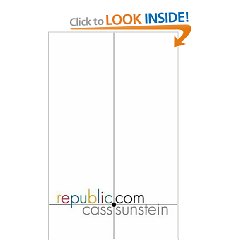 Essential Contribution to Democratic Dialog,
Essential Contribution to Democratic Dialog,
Cass R. Sunstein
It took me a couple of years to get to this book, but I am glad I did. Interestingly, it is dedicated to Judge Richard Posner, who has become quite a celebrity in writing and talking, from a legal point of view, about secret intelligence, in addition to his many other works.
The author's position is not completely new (see for instance Elizabeth Janeway's 1987 classic, “IMPROPER BEHAVIOR: When and How Misconduct Can be Healthy for Society”, and the more standard but still seminal “The Social Construction of Reality.”
The author rises beyond the law to embrace sociology, psychology, and philosophy, and in that vein, reminds me of Norman Dixon's classic work, “The Psychology of Military Incompetence.”
The core of the book addresses what the author names the two influences (most people get most of their information second-hand; and the general desire for good opinion of oneself) and the three phenomena (conformity, social cascades, and group polarization).
He notes that pluralistic ignorance is dangerous; that groups and systems work better when there are incentives for sharing information openly; and that “free speech” requires BOTH legal protection AND cultural acceptance.
He discusses the superiority of the more adaptive and open democratic decision making to that of totalitarian societies, but his description of their pathologies, ideas hatched in secret and for which no opposition will be accepted, sound starkly like Dick Cheney's Standard Operating Procedure–facsist control, lies to the public with impunity, and no tolerance for flag officers, including flag officers like Tony Zinni and General Shinseki, who have the courage to say that invading Iraq is not only nuts, it will be a disaster. For deep insights into Cheney's impeachable suprression of dissent, see “One Percent Doctrine,' “VICE: Dick Cheney and the Hijacking of the American Presidency,” and “Crossing the Rubicon”–and of course the various books on impeachment (see my list).
The author concludes with a special focus on the role of Judges and Senators as dissenting voices, and I am reminded of Senator Robert Byrd's courageous and erudite opposition to the illegal war on Iraq, with his speeches available to all in book form as “Losing America: Confronting a Reckless and Arrogant Presidency”).
The author concludes with a very disappointing section on education and affirmative action, and in this section, spoils an otherwise superb book by focusing on the banalities of affirmative action. Like George Bush and Hillary Clinton, he is toying with the cosmetics and avoiding the deep–the really deep–need for a complete recasting of education to fully integrate distance and self-paced online learning, multi-cultural learning, deep historical and cross-cultural understanding; a draconian Manhattan Project to improve desktop analytic tools and the need for an Information Economy Meta Language (IEML) such as Pierre Levy is creating (see his “Collective Intelligence”), as well as life-long learning, the localization of everything, and so on. I beg to emphasize this: it is the agricultural era school schedule (summer off) and the industrial era rote learning rigid structured program, that is killing the creativity of our kids while locking them up in a program that is nothing more than advanced child care with a semblance of prison population, the “club med” aspects for cheerleaders and jocks not-with-standing. Our HIGHEST national priority should be to churn education so that our kids are liberally and broadly educated and armed with all of the tools for thinking that the Central Intelligence Agency still does not have today because it too is a vestige of the Soviet era of gray desks and dumb telephones.
Thomas Jefferson had it right: “A Nation's best defense is an educated citizenry.” Cass Sunstein is arguably, with Lawrence Lessig, one of the greatest lawyers of our generation, but in the final section, he plops quietly.
Never-the-less, a five star book.
 Click Here to Vote on Review at Amazon,
Click Here to Vote on Review at Amazon,
on Cover Above to Buy or Read Other Reviews,
I Respond to Comments Here or There







